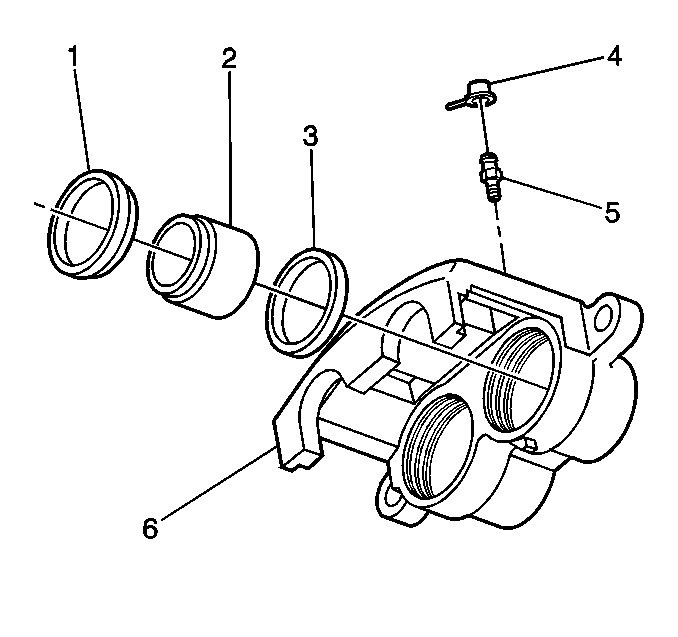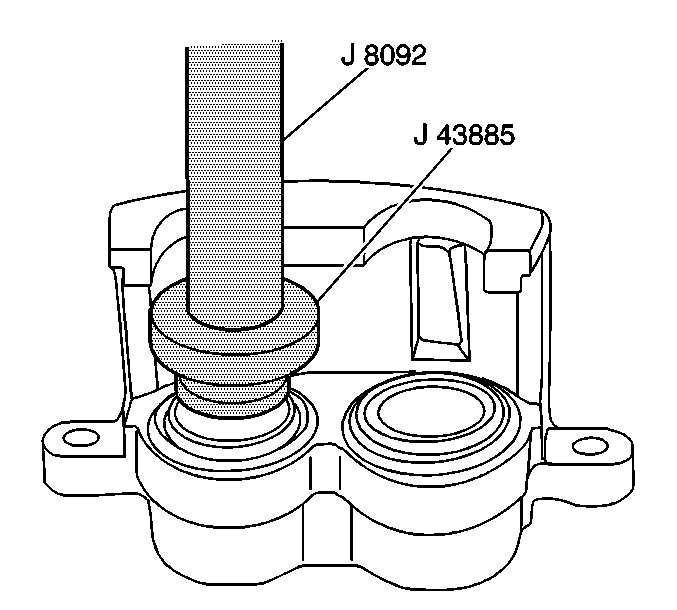Tools Required
Disassembly Procedure
Caution: Refer to Brake Dust Caution in the Preface section.
Caution: Refer to Brake Fluid Irritant Caution in the Preface section.

- Drain all the brake fluid from the caliper.
- Pad the interior of the caliper with clean shop towels.
Caution: Do not place your fingers in front of the piston in order
to catch or protect the piston while applying compressed air. This could result
in serious injury.
Notice: Use just enough air pressure to ease the piston out of
the bore. You can damage a blown-out piston even with the padding.
- Remove the pistons (2) from the caliper bores.
- Remove the boots (1) from the caliper bores. Do not scratch the
caliper bores.
- Remove the piston seals (3) from the caliper bores. Do not use
a metal tool.
- Remove the bleeder valve cap (4).
- Remove the bleeder valve (5) from the caliper housing (6).
- Clean the bleeder valve, the caliper bores, the caliper passages and
the pistons with denatured alcohol. Dry the parts and blow out the brake fluid
passages. Use dry and filtered compressed air.
- Replace the pistons or the caliper if any of the following conditions
exist:
| • | Scoring on the piston surface or in the caliper bore |
| • | Corrosion on the piston |
| • | Chrome plating damage on the piston |
| • | Corrosion in the caliper bore |
| • | Use a crocus cloth in order to polish light corrosion from the caliper bore.
Replace the caliper if the corrosion cannot be removed. |
| • | Pitting in the caliper bore |
Assembly Procedure

- Lubricate the new piston seals (3),
the caliper bores, and the pistons (2) using clean brake fluid.
- Install the piston seals (3). Ensure that the piston seals are
not twisted in the caliper bore grooves.
- Install the boot seals (1) on the pistons (2).
- Install the pistons in the caliper bores.
Notice: Use the correct fastener in the correct location. Replacement fasteners
must be the correct part number for that application. Fasteners requiring
replacement or fasteners requiring the use of thread locking compound or sealant
are identified in the service procedure. Do not use paints, lubricants, or
corrosion inhibitors on fasteners or fastener joint surfaces unless specified.
These coatings affect fastener torque and joint clamping force and may damage
the fastener. Use the correct tightening sequence and specifications when
installing fasteners in order to avoid damage to parts and systems.
- Install the bleeder valve (5) in the caliper housing (6).
Tighten
Tighten the bleeder valve to 7 N·m (62 lb in).
- Install the bleeder valve cap (4).

- Install
the boot seals into the caliper housing bores using the J 8092
and the J 43885
.



